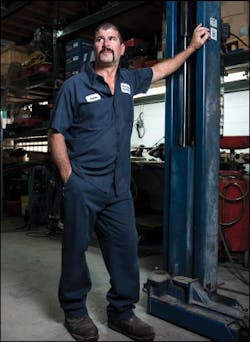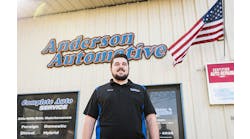James Partin has always had a unique work mix at his shop, Partin Diesel and Auto Repair in DeLand, Fla. On any given day, he says, he could be working on a pickup truck, a Volkswagen Jetta or an International series semi-truck.
And while the mix has helped differentiate the business from the competition, he says working on heavy-duty trucks came with some obstacles.
“You can’t use the same equipment you would for general repair,” he says. “You need separate tools and equipment for everything.”
And as those trucks were becoming more and more technologically advanced, Partin says he realized he needed to catch up.
The Background
Partin’s shop is a small operation: He acts as the shop’s sole technician and his wife, Jen, handles the front office operation. Partin says that when he started the shop in 2007, he knew he wanted to keep it small and play to his strengths.
Partin has been a self-described “big truck guy” since the beginning of his career. He started out working on big trucks in the mid-90s, doing transmission, driveline and mechanical work. He even had a stint selling big truck equipment for several years, before opening his own shop in 2008. The small shop now provides semi-truck and trailer repair, in addition to its work on cars, pickups and SUVs. As it’s grown over the years, Partin says that the work mix has become more balanced.
“I don’t do more of either,” he says. “Yesterday and today, I was working on International 4300 series trucks. Last night, I was working on an F-250 power stroke high-pressure oil pump. It varies.”
The Problem
Working on heavy-duty trucks has a number of advantages, chief among them the relatively little competition for those jobs in his area. The problem, Partin says, is that as trucks were becoming more and more technologically advanced, his lack of proper equipment was making it difficult to work on the vehicles.
“When I first started out, I was working on older trucks,” he says. “A lot of the diagnostics you could do by experience. But when they started with the exhaust gas recirculation (EGR) cooler and burn-off systems, I realized if I’m going to work on this stuff, I need a way to get in there and read codes and diagnose.”
Although Partin already had a number of scan tools in the shop, including a Snap-on SOLUS Ultra, a cartridge scanner for the older trucks and a Vantage sensor checking tool, he didn’t have heavy-duty truck-specific scan tool. And without that tool, Partin was forced to pay a technician friend who had a laptop with the necessary programs on it. He says he would have his friend come to the shop and perform the diagnostics on his own time.
“It takes time,” he says. “It was really inconvenient.”
Partin realized he had two choices: Either purchase a scan tool specifically for heavy-duty trucks, or quit working on the electronic side of the trucks and stick to what he refers to as the “bull work,” the brakes, airlines, water pumps and bearings. For a small, two-person shop only making $300,000 in sales a year, investing in a new scan tool is no easy matter. Doing so would require thorough research and ensuring a return on the investment.
“I thought about saying, ‘Maybe I should let the big-truck stuff go,’” he says. “I realized I’d really like to stay up with the trucks and the new stuff. I have a scanner to keep up with the cars and pickups to be current. I figured, I’m going to try it.”
The Solution
Partin worked closely with his Matco Tools representative to test numerous scan tools. Since he already knew the type of vehicles he wanted the scan tools to work on, he eliminated having to identify a make or model. Partin outlined the steps he took during his decision-making process:
1) Research the tools. Partin says this was the most crucial step in the process. He considered the tool’s coverage, ease of use, compatibility, upgrades and cost. He knew he wanted a tool that was user friendly, fast and reliable. Since he is the only technician in the shop, he says he couldn’t afford to spend a lot of time tinkering with a tool or troubleshooting a problem.
2) Demo the tools. This step was ultimately the deciding factor, says Partin. You need to have it in your hands and be able to see its full capabilities on your actual work mix. Testing the tool on your own is the most important thing you can do to make the correct decision. He was allowed to demo each tool for a week, which was when he got a feel for how the tool would actually work in his shop.
“Some tools wouldn’t let me in, others wouldn’t let me read this or that. One I was pretty excited about until I actually tried it. It locked up solid a couple times. I had to shut everything down and restart it,” he says.
3) Analyze the return. At $10,000, the tools weren’t inexpensive for a shop the size of Partin’s. Partin low-balled the return and compared the cost of the tool to the amount of money he would make on diagnostic charges. He says it helps give him an absolute minimum that can serve to directly pay off the tool.
“I looked at just for charging to hook it up, not counting the money it makes you by doing the actual work found,” he says.
After thorough testing, he decided that the Bosch ESI[tronic] Truck tool was the best fit for his facility.
“The first time I played with the [Bosch], I was hooked,” he says. “Everything I strapped it on, I’ve either read what I’ve wanted to read, or I’ve fixed it with it, or I’ve changed variables with it.”
The Bosch, he says, covers all major heavy-duty truck, MD truck, engine, transmission and brake system combinations with diagnostics and embedded repair information. It is able to run parameter resets, includes wiring diagrams, component information, electrical specification and troubleshooting for common error code causes.
“It works on some equipment right now, too,” says Partin. “A year from now, they’re steadily upgrading it on a daily, monthly, weekly basis.”
The Aftermath
Partin has had the tool for roughly eight months and is already a quarter of the way to recouping the cost of his investment. He is currently in the planning stages of advertising the tool through the business, which he thinks will help ramp up the heavy-duty truck business even more.
“I figure once I do that, then I should be hooking up to it twice a day and hopefully every day of the week,” he says. “Then I can probably get it paid off within the year.”
The Takeaway
Even for a small, two-person shop, Partin says that staying on top of technology and investing in the necessary tools and equipment is important. What’s even more important, however, is doing the proper research and testing to ensure the tool is the correct fit for the shop.
“I was struggling with some scanners,” he says. “It kind of worked OK and then it didn’t. I had to realize, I’m not paying for something that’s not doing what I need it to do.”



